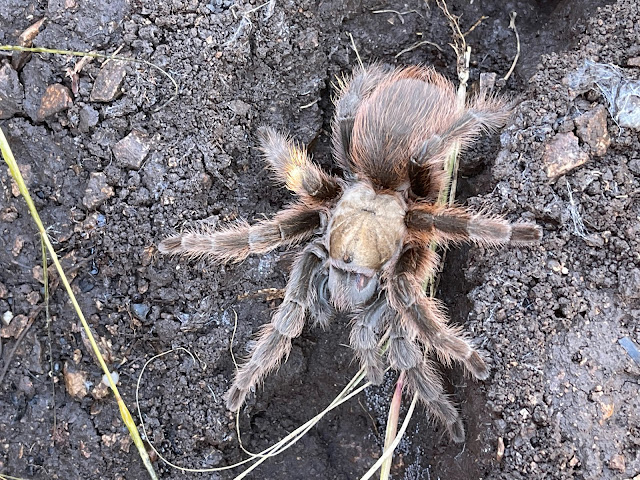 Chris Barnhart was hiking Rocky Barrens Conservation Area with Kevin Firth when he got these pictures of a tarantula. Kevin goes there regularly to check on burrows that hold them, knowing which rocks to lift up where they are hiding.
Chris Barnhart was hiking Rocky Barrens Conservation Area with Kevin Firth when he got these pictures of a tarantula. Kevin goes there regularly to check on burrows that hold them, knowing which rocks to lift up where they are hiding.
This is the Texas brown tarantula (TBT) Aphonopelma hentzi. There are over 900 tarantula species world wide. The MDC website says it is the largest spider in Missouri and the only species of tarantula found in Missouri versus 50 species in the US, mostly in the southwest. The female's body length averages 2" so you can imagine the length of the legs above.
 |
| Tarantula in hole to left, note silk lining |
Our TBT spends its days in its silk lined hole, predominately on rocky barren glades. They use holes created by rodents and reptiles and provide their own lining. Emerging at night to hunt, they predominately feed on crickets which they paralyze with venom, then chew while mixing their digestive juices with it before slurping up the liquid dinner.
After mating, the male pushes away vigorously, at times even causing her to fall on her back. He is avoiding the female's attack as he is no longer useful except as dinner where he would be nourishing his future offspring. He doesn't live long after that anyway so she likely considers him disposable.
She will lay out a sheet of silk and deposit her eggs with a nutritious fluid. She then guards the egg sac and even moves it to maintain the best temperature. Some tarantula species carry their egg sac for three months before the eggs hatch into the post embryo stage. They remain in that sac that Cowels describes in Amazing Arachnids as "eggs with legs." Once they absorb the rest of the egg juice they proceed to molt many times as they grow to adulthood.
Like all other arthropods, molting consists of growing a new larger cuticle under the old, then splitting out of the old outer coat with enzymes that break it down. Molting also renews the inner surfaces, such as the mouth, as well as external and for a period of time they can't eat during each molt. They are also softer and more vulnerable during this time. The good news is that with molting they can regrow a damaged or missing leg.
 |
| Fishing for a tarantula with grass |
Kevin was able to draw this tarantula out with a strand of grass. It grabbed on and he could slowly pull it out. This requires some patience as their bodies are somewhat fragile. They are covered with urticating barbed hairs that are stinging or irritating to the skin. Some species can shake these loose when irritated and inhaling them can be dangerous so don't make a habit of sniffing a tarantula.
They are slow moving and near-sighted. They sense the world largely through vibrations felt in another type of hair on their legs. To escape they can move more rapidly but not with accuracy. Many species are able to make sounds by rubbing their hairs on their legs together, called stridulation similar to crickets and some other insects.
*Fun fact. Female TBT have been known to live 30 years. Chris raised one as a pet for 10 years early in his marriage to the ever-patient Deb.
_________________________________________________________________
This is a vicarious two-part digital field trip to Rocky Barrens Conservation Area with Kevin Firth and Chris Barnhart. Next up, the Striped Bark Scorpion Centruroides vittatus.